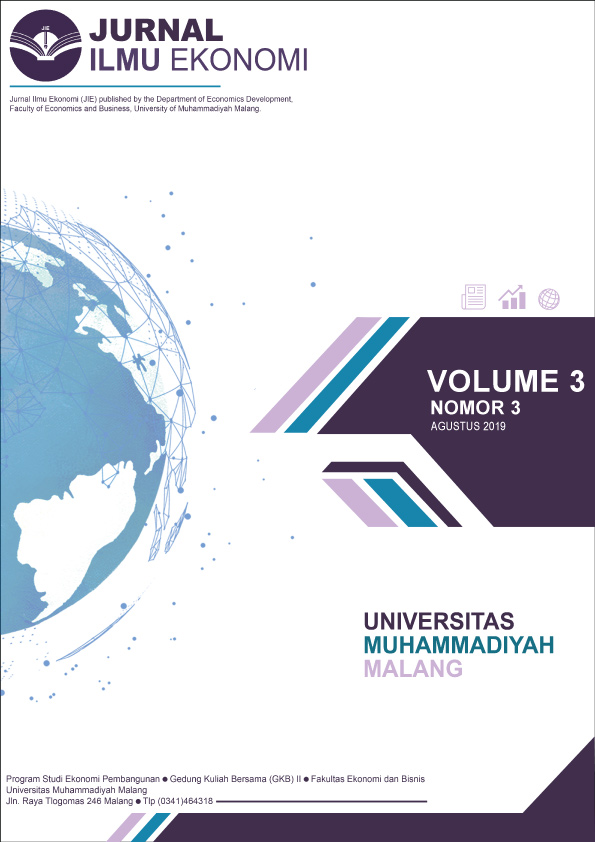ANALISIS PENGARUH BI RATE DAN KINERJA KEUANGAN BANK TERHADAP PEMBIAYAAN BANK SYARIAH DI INDONESIA (2010 - 2017)
DOI:
https://doi.org/10.22219/jie.v3i3.9014Keywords:
Financing, BI Rate, DPK, CAR, BOPOAbstract
This study aims to analyze the influence of the independent variables, namely the BI Rate, Third Party Funds (DPK), Capitalization of Adequacy Ratio (CAR) and Operational Income Costs (BOPO) on Islamic bank financing in Indonesia 2010 - 2017. This type of research is Quantitative Inferential . The required data is secondary data from the financial statements of five Islamic banks in Indonesia 2010-2017.4. Data analysis techniques are panel data regression analysis techniques. The results of the study show that the BI Rate variable has a significant negative effect on financing, Third Party Funds (TPF) have a significant positive relationship to financing, while for the variable Capital Adequacy Ratio (CAR) has a significant positive effect on financing and for Operational Income Operating Costs (BOPO) no significant negative effect on financing. The coefficient of determination (R ^ 2) is 0.938581 or 93.85%. This shows that the ability of the independent variables namely BI Rate, DPK, CAR and BOPO explain the dependent variable of Financing at 93.85% and the remaining 6.15% can be explained by other variables.
Downloads
References
Adipuryanti, N. L. Y., & Sudibia, I. K. (2013). Analisis Pengaruh Jumlah Penduduk Yang Bekerja Dan Investasi Terhadap Ketimpangan Distribusi Pendapatan Melalui Pertumbuhan Ekonomi Kabupaten/Kota Di Provinsi Bali. Jurnal Kependudukan Dan Pengembangan Sumber Daya Manusia, XI(1), 20–28. https://doi.org/10.1016/j.actaastro.2014.11.036
Aggina, D., & Artaningtyas, W. D. (2017). Pengaruh Pertumbuhan Ekonomi, Pertumbuhan Penduduk, Pertumbuhan Investasi, dan Indeks Pembangunan Manusia Terhadap Ketimpangan Distribusi Pendapatan di Daerah Istimewa Yogyakarta Tahun 2007-2014. Buleti Ekonomi, 15, 1–154.
Arifin, Z. (2012). Analisis Perbandingan Perekonomian Pada Empat Koridor di Propinsi Jawa Timur. Jurnal Humanity, 5.
Boedirachminarni, A., & Suliswanto, M. S. W. (2017). PENGEMBANGAN EKOWISATA DI KABUPATEN MALANG. Jurnal Ekonomi Pembangunan UMM, 15, 105–116.
BPS Nusa Tenggara Barat. (n.d.). Badan Pusat Statistik Nusa Tenggara Barat. Retrieved from https://ntb.bps.go.id/
Hartini, N. T. (2017). Pengaruh PDRB Perkapita, Investasi dan IPM Terhadap Ketimpangan Pendapatan Antar Daerah Di Provinsi DIY Tahun 2011-2015. Jurnal Pendididkan Dan Ekonomi, 6(6), 530–539. Retrieved from nitatrihartini@gmail.com
Kuncoro, M. (2004). Analisis Spasial san Regiona, Studi Aglomerasi dan Kluster Industri Indonesia (kedua). Yogyakarta: UPP AMP YKPN.
Kusuma, H. (2016). Desentralisasi Fiskal dan Pertumbuhan Ekonomi di Indonesia. Jurnal Ekonomi Kuantitatif Terapan, 9.
Nangarumba, M. (2015). Analisis Pengaruh Struktur Ekonomi , Upah Minimum Provinsi , Belanja Modal , dan Investasi Terhadap Ketimpangan Pendapatan di Seluruh Provinsi di Indonesia Tahun 2005-2014. Jesp, 7(2), 9–26.
Nuraini, I. (2012). Analisis Sumber-Sumber Pertumbuhan Output Regional Kota Malang, 5, 109–115.
Pradnyadewi, D., & Purbadharmaja, I. B. (2017). Pengaruh IPM, Biaya Infrastruktur, Investasi Dan Pertumbuhan Ekonomi Terhadap Ketimpangan Distribusi Pendapatan Di Provinsi Bali. E-Jurnal EP Unud, 6(2), 255–285.
Saputra, N. C. (2016). Analisis pengaruh pertumbuhan ekonomi, pengangguran,dan indeks pembangunan manusia terhadap ketimpangan pendapatan antar kabupaten/kota di Provinsi jawa timur. Malang.
Sukirno, S. (2006). Ekonomi Pembanguanan, Proses, Masalah dan Dasar Kebijakan. Jakarta: Kencana.
Sultan, & Sodik, J. (2010). Analisis Ketimpangan Pendapatan Regional Di DIY-Jawa Tengah Serta Faktor-Faktor Yang Mempengaruhi Periode (2000-2004). Buletin Ekonomi, 8(1), 1–70.
Susilowati, D., Sri, M., & Suliswanto, W. (2015). MANUSIA , UTANG LUAR NEGERI DAN KEMISKINAN ( KAJIAN TEORITIS DI INDONESIA ), 89–106.
Todaro, M. P., & Smith, S. C. (2011). Pembangunan Ekonomi (kesebelas). Jakarta: Erlangga.
Yuliani, T. (2014). Pertumbuhan Ekonomi dan Ketimpangan Pendapatan Antar kabupaten di kalimantan Timur. JEJAK, 8(Journal of Economics and Policy).
Downloads
Published
How to Cite
Issue
Section
License
Copyright (c) 2019 Jurnal Ilmu EKonomi JIE

This work is licensed under a Creative Commons Attribution-ShareAlike 4.0 International License.
Authors who publish with this journal agree to the following terms:
- For all articles published in the JIE (Jurnal Ilmu Ekonomi), copyright is retained by the authors. Authors give permission to the publisher to announce the work with conditions. When the manuscript is accepted for publication, the authors agree to the automatic transfer of non-exclusive publishing rights to the publisher.
- Authors retain copyright and grant the journal right of first publication with the work simultaneously licensed under a Creative Commons Attribution-NonCommercial-ShareAlike 4.0 International License that allows others to share the work with an acknowledgement of the work's authorship and initial publication in this journal.
- Authors are able to enter into separate, additional contractual arrangements for the non-exclusive distribution of the journal's published version of the work (e.g., post it to an institutional repository or publish it in a book), with an acknowledgement of its initial publication in this journal.
- Authors are permitted and encouraged to post their work online (e.g., in institutional repositories or on their website) prior to and during the submission process, as it can lead to productive exchanges, as well as earlier and greater citation of published work (See The Effect of Open Access).
This is an open access article and licensed under a Creative Commons Attribution-NonCommercial-ShareAlike 4.0 International License








